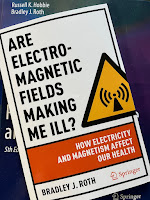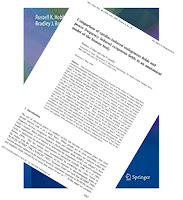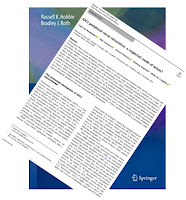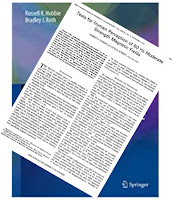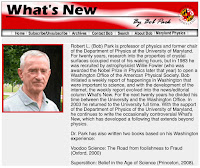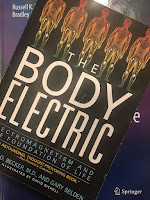 |
The Body Electric,
By Robert Becker and Gary Selden
|
Go to
www.amazon.com and look up the best selling book in the category “
biophysics.” You’ll often find #1 is
The Body Electric: Electromagnetism and the Foundation of Life, by
Robert Becker and Gary Selden. (Selden helped with the writing, but the book tells Becker’s story.) The purpose of today’s post is to explain why this book is awful.
1. Let’s begin with Becker’s views on
nerve conduction (page 86).
“According to the theory, an impulse should travel with equal ease in either direction along the nerve fiber. If the nerve is stimulated in the middle, an impulse should travel in both directions to opposite ends. Instead, impulses travel only in one direction; in experiments they can be made to travel ‘upstream,’ but only with great difficulty. This may not seem like such a big deal, but it is very significant. Something seems to polarize the nerve.”
I stimulated many nerves as a graduate student, back in the days when I did experiments. Action potentials propagate just fine in either direction. I had no difficulty making one travel upstream.
2. Becker didn’t understand why nerves, which fire all-or-none action potentials, can produce smooth, coordinated muscle movements (page 87).
“In addition, impulses always have the same magnitude and speed. This may not seem like such a big thing either, but think about it. It means the nerve can carry only one message, like the digital computer’s 1 or 0… The motor activities we take for granted—getting out of a chair and walking across the room, picking up a cup and drinking coffee, and so on—require integration of all the muscles and sensory organs working smoothly together to produce coordinated movements that we don’t even have to think about. No one has ever explained how the simple code of impulses can do all that.”
A muscle contains many
motor units. Each motor unit is controlled by a single
motor neuron. If you want a muscle to contract with a small force, you activate one motor unit. If you want a muscle to contract more forcefully, you activate many motor units. Motor unit recruitment, plus changes in nerve firing rate, explains the smooth operation of muscles.
3. Becker didn’t believe that nerves worked using ionic currents, meaning the movement of ions like sodium, potassium, and chloride dissolved in the salt water that makes up our tissues (page 92).
“At that earlier time, there had been only two known modes of current conduction, ionic and metallic. Metallic conduction can be visualized as a cloud of electrons moving along the surface of metal, usually a wire. It can be automatically excluded from living creatures because no one has ever found any wires in them. Ionic current is conducted in solutions by the movement of ions—atoms or molecules charged by having more or fewer than the number of electrons needed to balance their protons’ positive charges. Since ions are much bigger than electrons, they move more laboriously through the conducting medium, and ionic currents die out after short distances. They work fine across the thin membrane of the nerve fiber, but it would be impossible to sustain an ionic current down the length of even the shortest nerve.”
Regular readers of this blog will recall my post about Baker, Hodgkin and Shaw’s experiment in which they squeezed the axoplasm out of a squid nerve axon and replaced it with salt water. The nerve worked just fine.
Some individual molecules work by transfer of electrons (for instance, the electron transport chain in mitochondria), but currents flowing through tissue are produced by ions. Ionic currents don’t “die out” after short distances.
4. Instead of ionic conduction, Becker believed that nerves conducted electricity by semiconduction (page 94).
“I postulated a primitive, analog-coded information system that was closely related to the nerves but not necessarily located in the nerve fibers themselves. I theorized that this system used semiconducting direct currents and that, either alone or in concert with the nerve impulse system, it regulated growth, healing, and perhaps other basic processes.”
Later, he performed measurements of the
Hall effect (a voltage induced by current flowing in a magnetic field) and wrote (page 102):
“The experiment demonstrated unequivocally that there was a real electric current flowing along the salamander’s foreleg, and it virtually proved that the current was semiconducting. In fact, the half-dozen tests I’d performed supported every point of my hypothesis.”
Scientists have made semiconductors based on biological ideas:
organic semiconductors and semiconductors based on
synthetic biology. But there’s no evidence that semiconductors play a role in our normal physiology. Our bodies are basically all salt water. Ionic conduction is the way currents flow through our tissue.
5. Becker declared he had discovered the mechanism of acupuncture (page 234).
“The acupuncture meridians, I suggested, were electrical conductors that carried an injury message to the brain, which responded by sending back the appropriate level of direct current to stimulate healing in the troubled area…. If the lines and points [corresponding to acupuncture meridians] really were conductors and amplifiers, the skin above them would show specific electrical differences compared to the surrounding skin.”
Acupuncture is based on
pseudoscience; No anatomical structures such as “
meridians” exist, and the vital force “
qi” has never been observed.
Listen to
Harriet Hall describe acupuncture.
Read what
Edzard Ernst says.
6. Becker asserted that static magnetic fields could act as an anesthetic (page 238).
“A strong enough magnetic field oriented at right angles to a current magnetically ‘clamped it’, stopping the flow [of current]. By placing frogs and salamanders between the poles of an electromagnet so that the back-to-front current in their heads was perpendicular to the magnetic lines of force, we could anesthetize the animals just as well as we could with chemicals.”
Such neurological effects are not caused by static magnetic fields. Patients have undergone
magnetic resonance imaging in static magnetic fields far larger than what Becker used, and no one has been anesthetized, regardless of the orientation of their head.
Using magnets for pain
has been discredited.
7. Becker thought that the cells forming the myelin sheaths surrounding myelinated nerve axons carried their own electric current that could have biological effects (page 239).
“Electron microscope work has shown that the cytoplasm of all Schwann cells is linked together through holes in the adjacent membranes, forming a syncytium that could provide the uninterrupted pathway needed by the current.”
The Schwann cells make up the myelin sheath. Myelin consists of layers of fat with little cytoplasm between the layers. Its purpose is to insulate a nerve between openings called
nodes of Ranvier. There is no evidence myelin carries significant current, but even if it did carry current along a nerve through the myelin, it would be interrupted ever millimeter or so by a node.
8. Becker believed that magnetoencephalography confirmed his claim that DC current existed in the brain (page 241)
“The MEG research so far seems to be establishing that every electrical evoked potential is accompanied by a magnetic evoked potential. This would mean that the evoked potentials and the EEG of which they’re a part reflect true electrical activity, not some artifact of nerve impulses being discharged in unison, as was earlier theorized. Some of the MEG’s components could come from such additive nerve impulses, but other aspects of it clearly indicate direct currents in the brain.”
DC currents in the brain are uncommon, and primarily associated with brain injury or
migraines. Researchers in
biomagnetism interpret their results as arising from additive nerve impulses, discharged in unison.
9. Becker promoted the idea that extrasensory perception was a result of DC or extremely low frequency (ELF) electromagnetic fields (page 267).
“At this time the DC perineural system [myelin sheaths around nerves] and its electromagnetic fields provide the only theory of parapsychology that’s amenable to direct experiment. And it yields hypotheses for almost all such phenomena except precognition. Telepathy may be transmission and reception via a biologically programmed channel of ELF vibrations in the perineural system’s electromagnetic field.”
What can I say?
I don’t believe in extrasensory perception.
10. Becker suggested electromagnetic effects could explain psychokinesis, such as spoon-bending by pure thought (page 269).
“Once we admit the idea of this kind of influence, then the same kind of willed action of biofields on the electromagnetic structure of inanimate matter becomes a possibility. This encompasses all forms of psychokinesis, from metal-bending experiments in which trickery has been excluded to more rigidly controlled tests with interferometers, strain gauges, and random number generators.”
I don’t believe in psychokinesis either. Neither did
James Randi, who died just a year ago.
11. Becker claimed that weak magnetic fields could affect cognitive ability in humans (page 276).
“We exposed volunteers to magnetic fields placed so the lines of force passed through the brain from ear to ear, cutting across the brainstem-frontal current. The fields were 5 to 11 gauss [0.0005 to 0.0011 tesla], not much compared with the 3,000 gauss needed to put a salamander to sleep, but ten to twenty times earth’s background and well above the level of most magnetic storms. We measured their influence on a standard test of reaction time—having subjects press a button as fast as possible in response to a red light. Steady fields produced no effect, but when we modulated the field with a slow pulse of a cycle every five seconds (one of the delta-wave frequencies we’d observed in salamander brains during a change from one level of consciousness to another), people’s reaction slowed down.”
Many reviews of the
biological effects of magnetic fields conclude there are no such effects.
12. Becker championed the idea that 60-Hz, power line magnetic fields could cause cancer. But he went even further, saying the such “electropollution” could threaten human existence (page 327).
“Everyone worries about nuclear weapons as the most serious threat to our survival. Their danger is indeed immediate and overwhelming. In the long run, however, I believe the ultimate weapon is manipulation of our electromagnetic environment, because it’s imperceptibility subtle and strikes at the core of life itself. We’re dealing here with the most important scientific discovery ever—the nature of life. Even if we survive the chemical and atomic threats to our existence, there’s a strong possibility that increasing electropollution could set in motion irreversible changes leading to our extinction before we’re even aware of them.”
The “electropollution” Becker speaks of is weak electric and magnetic fields, such as produced by power lines. Power line magnetic fields are safe, and earlier claims that they are not have been shown to be false (see my previous post). “Electropollution” is closer to an imaginary threat than an existential one.
What do I make of all this? Becker’s book is full of nonsense. Moreover, I know little about some of the topics in the book, such as regeneration, bone growth, and injury currents. There could well be more mistakes than just those I’ve caught.
Becker died almost twelve years ago. Am I beating a dead horse? No. According to Google Scholar, The Body Electric has been cited more than 1000 times in the scientific literature (twice as many times as Intermediate Physics for Medicine and Biology), including over 25 times in 2021 already. It’s cited by the supporters of the worst kind of alternative medicine foolishness. The 5G opponents quote him. The power lines and cancer folks quote him. The magnets for pain promoters quote him.
You might wonder: am I upset just because The Body Electric gets more sales and citations than IPMB? Well, maybe that’s part of it. But I believe debunking Becker’s book is a public service. People need to learn real science.
My favorite story in The Body Electric is the time a bigwig physiologist visited Becker’s lab, and told him outright that his results were “artifact, all artifact” (page 106). Thereafter, Becker and his colleagues referred to this fellow derisively as “Artifact Man” and held him up as a symbol for dogmatism. I love Artifact Man.
Chapter 1 sums up Becker’s view of medicine with a defense of “faith healing, magic healing, psychic healing, and spontaneous healing” (page 25). He goes on to say (page 29)
“The more I consider the origins of medicine, the more I’m convinced that all true physicians seek the same thing. The gulf between folk therapy and our own stainless-steel version is illusory. Western medicine springs from the same roots and, in the final analysis, acts through the same little-understood forces as its country cousins. Our doctors ignore this kinship at their—and worse, their patients’—peril. All worthwhile medical research and every medicine man’s intuition is part of the same quest for knowledge of the same elusive healing energy.”
No, No, No. The origins of medicine should be science. The gulf between folk therapy and modern medicine is wide and must get wider. Our doctors ignore science at their—and worse, their patients’—peril.
Okay, I’m done now. I realize this post is more of a rant than is usual for me. Sorry
about that, but there’s something about The Body Electric that really gets
my goat.
